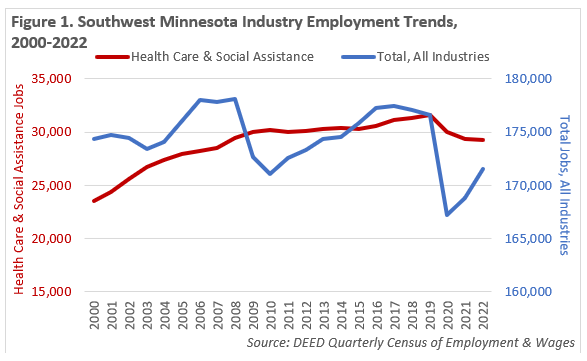 Southwest Minnesota is a national leader in agricultural production, and renewable energy.
Southwest Minnesota is a national leader in agricultural production, and renewable energy.
The region's thriving manufacturing sector includes food processing, machinery, printing, metal products, and computers and electronic products.
Want the freshest data delivered by email? Subscribe to our regional newsletters.
6/14/2023 9:00:00 AM
Luke Greiner, Amanda O'Connell
Health Care & Social Assistance is an ever-evolving industry that demands skilled and compassionate workers to provide essential support and care to patients. In Southwest Minnesota, the demand for Healthcare Support occupations is on the rise, offering promising opportunities for individuals seeking fulfilling careers in the healthcare sector.
Despite cutting more than 2,000 jobs over the past four years due to the Pandemic Recession, Health Care & Social Assistance still provides more than 29,000 jobs in the region, accounting for 17% of total employment, or one in every 6 jobs. It was easily the largest growing industry in the region over the past two decades, even with the recent job losses, adding more than 5,700 jobs since 2000 (see Figure 1).

According to the most recent Job Vacancy Survey, there were more than 45,000 openings in Health Care & Social Assistance statewide, easily the largest number of any industry. In Southwest, there were nearly 3,600 Health Care job vacancies, the most of any industry and the third highest amount on record in the region. This blog post highlights some of the in-demand healthcare occupations in Southwest Minnesota and explores the rewarding aspects of pursuing these roles.
Nursing Assistants (CNA) play a crucial role in providing direct patient care. CNAs provide or assist with basic care or support under the direction of onsite licensed nursing staff, performing duties such as monitoring health status, feeding, bathing, dressing, grooming, toileting, or ambulation of patients in a health or nursing facility. They are an integral part of the healthcare team, working closely with nurses and physicians to ensure the comfort and well-being of patients. With the aging population and increased healthcare needs, the demand for CNAs in Southwest Minnesota is growing rapidly, more than doubling to nearly 600 vacancies in 2022, making it a promising career choice for those passionate about helping others.
As the need for primary care services continues to expand, the demand for Home Health Aides (HHA) and Personal Care Aides (PCA) in Southwest Minnesota is increasing. There were more than 450 vacancies for HHAs and PCAs in 2022, with a median wage offer around $13.50. HHAs and PCAs Provide personalized assistance to individuals with disabilities or illness who require help with personal care and activities of daily living support (e.g., feeding, bathing, dressing, grooming, toileting, and ambulation). They may also provide help with tasks such as preparing meals, doing light housekeeping, and doing laundry. The work is performed in various settings depending on the needs of the care recipient and may include locations such as their home, place of work, out in the community, or at a daytime nonresidential facility.
Licensed Practical Nurses (LPN) care for ill, injured, or convalescing patients or persons with disabilities in hospitals, nursing homes, clinics, private homes, group homes, and similar institutions. Typically trained at 2-year technical colleges, the Minnesota Board of Nursing requires a license to work in this career. There were more than 450 vacancies in 2022, the second highest number ever reported in the region, with a median wage offer of $21.81 and a median wage of just over $25 per hour for working LPNs.
Finally, demand remained strong for Registered Nurses (RN) in Southwest Minnesota, with just over 275 vacancies in 2022. Requiring an associate's degree or a bachelor's degree, RNs assess patient health problems and needs, develop and implement nursing care plans, and maintain medical records. They also administer nursing care to ill, injured, convalescent, or disabled patients and may advise patients on health maintenance and disease prevention or provide case management. This occupation offers a dynamic and fast-paced work environment, with opportunities to work in clinics, hospitals, and other healthcare facilities. Wages have risen rapidly for RNs in recent years, hitting $38.80 at the median.
The healthcare industry in Southwest Minnesota is experiencing strong demand for skilled professionals in various occupations. From CNAs, HHAs and PCAs, LPNs and RNs, to Medical Assistants, Pharmacy Technicians and Medical Billing and Coding Specialists, these roles offer diverse and rewarding career paths for individuals interested in making a difference in the lives of others. The region's growing healthcare needs, coupled with the potential for personal and professional growth, make Southwest Minnesota an excellent place to pursue a healthcare support occupation. Whether you have a passion for direct patient care or prefer the administrative side of healthcare, there are abundant opportunities waiting to be explored in this dynamic and vital industry.
Contact Luke Greiner at luke.greiner@state.mn.us or Amanda O'Connell at amanda.oconnell@state.mn.us.
June is the kick off for the Follow Your Heart to a Caring Career campaign, including a proclamation from the Governor explaining the benefits of working in Health Care & Social Assistance. DEED's Regional Analysts put together a series of blogs focused on Health Care employment and opportunities in all 6 planning regions:
Central | Northeast | Northwest | Southeast | Twin Cities
As detailed in previous articles, the Health Care & Social Assistance industry has been under stress since the pandemic, but remains a great long-term career opportunity as it is projected to be the largest growing industry over the next decade. The goal of the Caring Careers campaign is to help jobseekers find their fit in health care employment that makes a real difference in the lives of others. Jobseekers that are interested can begin an in-demand career path with great growth potential and no training beyond high school required to start in many positions. Employers even pay for initial training in many cases – and they may also pay for future training to help workers grow their career and earn more money. Many employers also welcome employees who are learning English.